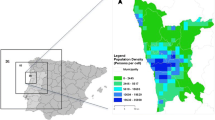Abstract
Optimization algorithms for control of industrial emission parameters with environmental and economic criteria are considered. Combination of the vector relaxation with external penalty function methods is used for multi-objective optimization. The optimization algorithms are developed for air quality management in decision support information systems and to generate some necessary emission scenarios in integrated air pollution models too.
Access this chapter
Tax calculation will be finalised at checkout
Purchases are for personal use only
Similar content being viewed by others
References
Afshartous D, Guan Y, Mehrotra A (2009) US coast guard air station location with respect to distress calls: a spatial statistics and optimization based methodology. Eur J Oper Res 196:1086–1096
Arrow KJ, Hurwicz L, Uzawa H (1958) Studies in linear and non-linear. Programming. Stanford University Press, Stanford
Bejko IV, Nochvai VI (2008) Modeling and optimization of emission processes parameters in urban atmosphere. J “Math comput model”. Series: Physics and mathematic – Kamyanets-Podilsky, vol 1, pp 25–32 (in Ukrainian)
Carnevale C, Pisoni E, Volta M (2008) A multi-objective nonlinear optimization approach to designing effective air quality control policies. Automatica 44:1632–1641
Hakami A, Odman MT, Russell AG (2004) Non-linearity in atmospheric response: a direct sensitivity analysis approach. J Geophys Res 109:D15303
Holnicki P (2006) On the real-time emission control – case study application. Control Cybern 235:351–367
Holnicki P, Sokolowski J, Zochowski A (1987) Diferential stability of solutions to air quality control problems in urban area. Appl Math 32(3):240–253
Ismael A, Vaz F, Ferreira EC (2009) Air pollution control with semi–infinite programming. Appl Math Model 33:1957–1969
Izmailov AF (2006) Sensitivity in optimization, Moscow (in Russian)
Makowski M (2008) Multi-objective decision support including sensitivity analysis. International Institute for Applied Systems Analysis, Laxenburg, pp 21–22
Mallet V, Sportisse B (2005) A comprehensive study of ozone sensitivity with respect to emissions over Europe with a chemistry-transport model. J Geophys Res 110(D22)
Marchuk GI (1986) Mathematical models in environmental problems. Elsevier, Amsterdam
Seibert P, Frank A (2004) Source-receptor matrix calculation with a Lagrangian particle dispersion model in backward mode. Atmos Chem Phys 4:51–63. doi:10.5194/acp-4-51-2
Shavrina AV, Sosonkin MG, Veles AA et al (2008) Integrated modeling of surface and tropospheric ozone for Kyiv city. In: Barnes I, Kharytonov MM (eds) Simulation and assessment of chemical processes in a multiphase environment, vol 25, NATO science for peace and security series C: environmental security. Springer, Dordrecht, pp 345–357
Tong D, Muller N, Kan H, Mendelsohn R (2009) Using air quality modeling to study source-receptor relationships between nitrogen oxides emissions and ozone exposures over the United States. Environ Int Nov 35(8):1109–17
Zhang Y, Bischof C, Easter R, Wu P (2005) Sensitivity analysis of photochemical indicators for O3 chemistry using automatic differentiation. J Atmos Chem 51:1–41
Author information
Authors and Affiliations
Corresponding author
Editor information
Editors and Affiliations
Rights and permissions
Copyright information
© 2011 Springer Science+Business Media B.V.
About this paper
Cite this paper
Nochvai, V. (2011). Multi-objective Optimization of Emission Parameters for Air Pollution Models. In: Steyn, D., Trini Castelli, S. (eds) Air Pollution Modeling and its Application XXI. NATO Science for Peace and Security Series C: Environmental Security. Springer, Dordrecht. https://doi.org/10.1007/978-94-007-1359-8_115
Download citation
DOI: https://doi.org/10.1007/978-94-007-1359-8_115
Published:
Publisher Name: Springer, Dordrecht
Print ISBN: 978-94-007-1358-1
Online ISBN: 978-94-007-1359-8
eBook Packages: Earth and Environmental ScienceEarth and Environmental Science (R0)




